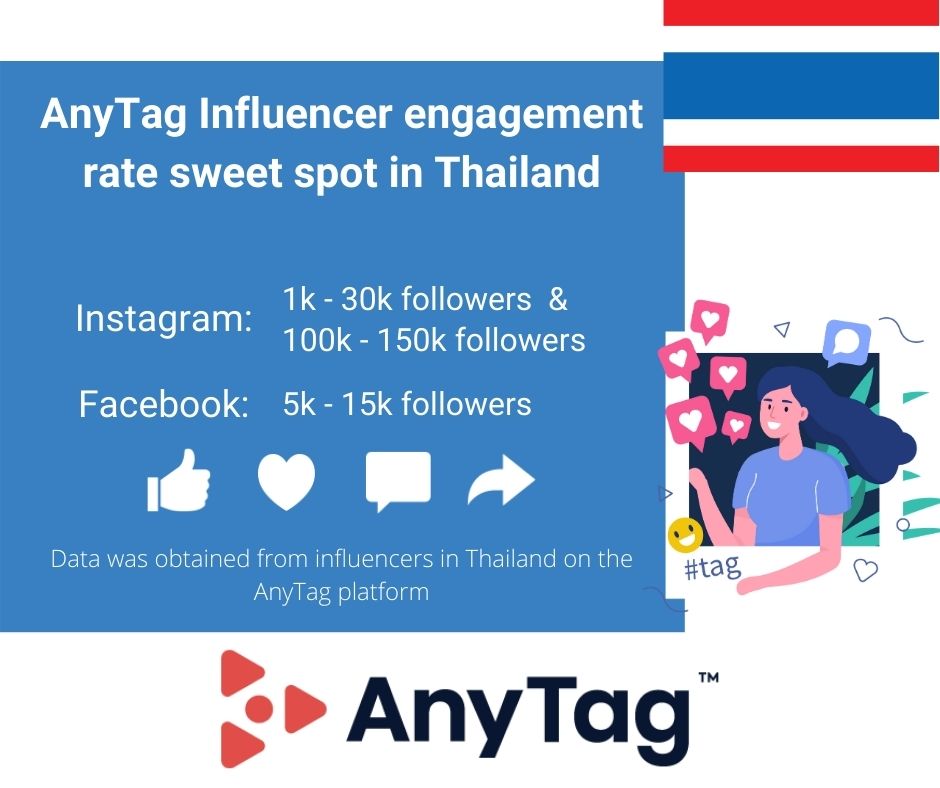Download: State of Influence in Asia 2021 report now
Thailand ranks as one of the fastest-growing markets for influencer marketing in Southeast Asia, and rightly so. With an increasing number of residents looking to become more connected than ever before, platforms like Facebook, LINE and Instagram are effectively connecting a fast-digitizing population.
With an increasing number of users online, it is no wonder that marketing functions in Thailand are shifting towards online channels over the past eight years, according to a report by the Digital Advertising Association of Thailand (DAAT).
In a 2020 report by We Are Social and Hootsuite, 52 million users (75% of the population) were connected to the internet in January 2020, with a similar number of people on social media platforms (52 million users at 75% of the population). The same report highlighted social media users increased by 2.3 million (4.7% growth) between April 2019 and January 2020.
That’s not all though – internet usage stands at a whopping nine hours a day on average, with social media usage close to three hours a day on average (or close to 12.5% of a day, without sleep!).
All these stats are encouraging, but we have to ask the perennial question: “Where are these users on?”
It is amazing how much Facebook and YouTube have captured the population, with each holding 94% of all internet users in the aforementioned report. Instagram, Twitter and fast-rising star, TikTok make up the top five most-used social media platforms in Thailand.

“What about influencer marketing?” we hear you ask – based on data from the AnyTag platform (formerly known as CastingAsia), influencers are predominantly on YouTube, Facebook and Instagram. However, the past few months saw a sharp rise in the number of influencers starting up on TikTok.
In recent years, there has also been a proliferation of celebrities and high profile personalities creating more content on social media, a move that looked to open new avenues for them to engage with their fans (rather successfully we have to say). At the same time, we are seeing a stark rise in the number of micro and nano-influencers in Thailand, as social media continues its steady rise.
What are brands doing for influencer marketing in Thailand? Taking a closer look at the verticals where influencer marketing is most utilized, companies in the FMCG, beauty, e-commerce, automotive, gaming, gadgets, retail and finance, are the frontrunners, which reflect similar fields As the “2019 Top Industry Spending” section in the DAAT report mentioned above.
Additionally, content created by influencers for the FMCG, beauty, gaming and automotive verticals saw the highest engagement rates – a similar trend when it came to shares or post saves.

For lower-funnel objectives like clicks and conversions, a similar trend followed our insights into Indonesia and Japan – where post engagement or number of followers do not necessarily reflect the number of clicks or conversions, but a slight correlation was found between the number of shares on a post with a higher click rate. The biggest factor that drove a larger amount of clicks is by which influencer posted. Influencers who regularly posted similar types of content saw a higher amount of clicks on their content.
This highlights the importance of understanding deeper insights into an influencer and their followers – running content that goes against what an influencer believes in or regularly shares with their followers will result in lower audience resonance.
Social influencers and influencer trends Diving into AnyTag’s pool of influencers, we take a look at the most popular categories for social media influencers in Thailand. Arts & entertainment was the most popular category for influencers, followed by fashion & lifestyle influencers. The top five is rounded up by the beauty, travel and food categories.
Looking at the follower-to-engagement rates for popular social media platforms in Thailand, the sweet spot for Instagram drove two distinct areas: those with 1,000 to 30,000 followers (nano-influencers and micro-influencers), and 100,000 to 150,000 followers (micro-influencers and macro-influencers). Facebook is a slightly different story, with those in the 5,000 to 15,000-follower range performing the best.

Tips from our team in Thailand With influencer marketing being used most regularly for upper-funnel objectives, utilizing social media platforms that are brand-friendly and allows influencers to create creative content is the way forward.
With content creation becoming easier and more accessible, the number of influencers will continue to rise in Thailand and the world. As such, influencers will need to find a way to stand out from the crowd through fun, creative and engaging content to draw in audiences.
On the other side of the equation, this will result in an overload of content across social media platforms, and as a marketer, it is important to pick the best influencers that match your brand image.
Once a marketer is done choosing the right social media platform for an influencer marketing campaign, it is necessary to understand your target audience based on the type of influencers you’re bringing into the campaign, in order to optimize campaign objectives by implementing the different strategies that apply to each category.
There are certain tiers of influencers as shown in the chart below, and analyzing various types of influencers will help you to define a niche target audience for your campaign.

Top Stars are those with more than a million followers, and are effective in driving impressions, reach and brand lift.
Macro-influencers in Thailand are those who have 100,000 followers to a million followers, with engagements and views the most common objectives.
Micro-influencers in Thailand are those with 10,000 to 100,000 followers, and have proven effective in driving clicks and conversions.
Rounding up the pyramid are nano-influencers and end-users, and the common strategy is to leverage their influence in driving brand connections, credibility and loyalty amongst their follower base.

At the same time, Thai marketing media, MarketingOops, has highlighted several categories of influencers, and they are:
Key Opinion Leader: Those who own authority over a specific topic and has the experience and the influence to engage and impact people. These include doctors, academics, professional advisors, designers, and more, and can fall anywhere from end-users to top stars.
Icon: These are personalities that have loyal followers or fanbases who are willing to buy products that their icon is using or promoting as a form of support.
Tribe Leader: These are leaders from different communities. Audiences usually respect and listen to their opinions, and they are often the leading authority in their community.
Social Peer: These are social connectors and can be anyone around us. They are able to spread messages through word-of-mouth or promoting certain social norms.
AnyMind Group’s offerings in Thailand Apart from AnyMind Group’s offerings in advertising for Thailand through AnyDigital, VGI AnyMind and POKKT Mobile Ads, marketers in Thailand can leverage on a strong pool of influencers to drive their influencer marketing campaigns.
Starting from the acquisition of Moindy in March 2019, and the subsequent launch of AnyCreator (previously known as CastingAsia Creators Network), marketers can tap onto a wide base of celebrities, musicians, social media influencers and more in Thailand for influencer marketing campaigns.
Adding to that, AnyTag (previously known as CastingAsia) provides marketers with a one-stop platform for all influencer marketing activities – from discovering influencers, setting up campaigns, managing influencers and content, to attribution and reporting, AnyTag-driven influencer marketing campaigns in Thailand now have a sharp competitive edge.
We also have on-the-ground experts that have years of experience running influencer marketing campaigns, who will empower you to find the best strategy or help you in coordinating highly-complicated influencer marketing initiatives.
Round-ups from other markets • Social media influencer marketing in Indonesia • Social media influencer marketing in Japan • Social media influencer marketing in Vietnam • Social media influencer marketing in the Philippines • Social media influencer marketing in Singapore • Social media influencer marketing in Hong Kong

Influencer verticals
Overview of influencer marketing in Thailand – Download here
Arts & Entertainment influencer report for Thailand – Download here
Fashion & Lifestyle influencer report for Thailand – Download here
Travel influencer report for Thailand – Download here
2021
State of Influence in Asia 2021 report – Download here
If you’d like to find out more about social media influencer marketing in Thailand, try out the AnyTag platform, or speak to a representative, please fill out the form below.










